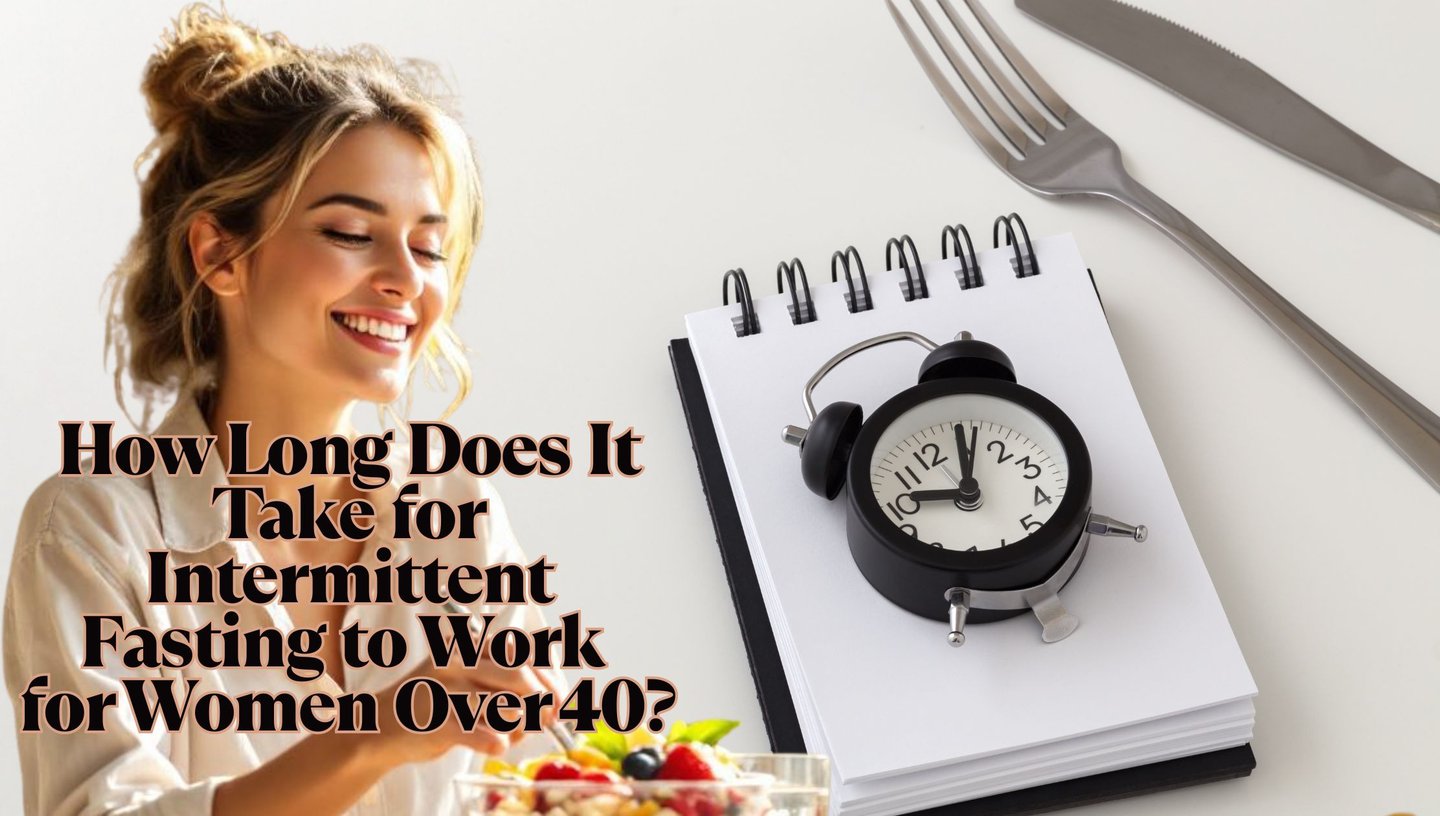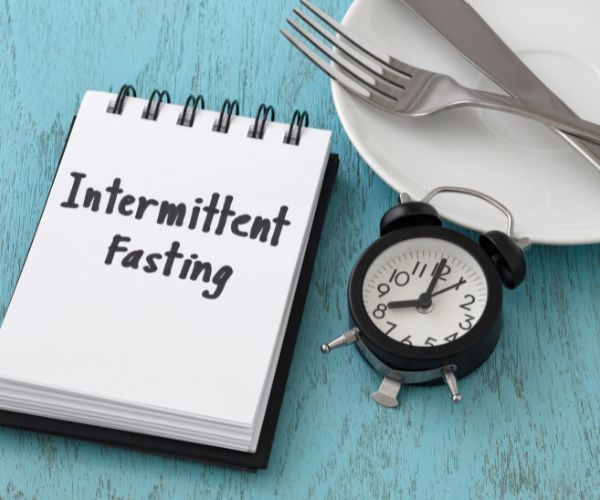How Long Does It Take for Intermittent Fasting to Work for Women Over 40?
See how long does it take for intermittent fasting to work for women over 40 including first signs of progress and advice for steady, healthy weight loss.
HEALTH & WELLNESS
Shari Smith
7/27/202511 min read
As an Amazon affiliate, we earn commissions at no extra cost to you if you click our links and make a purchase.


Intermittent fasting isn't just another health trend. It's become a popular way for women over 40 to manage weight, regain energy, and feel better day to day.
If you're wondering how long it takes for intermittent fasting to work, you aren't alone. Many people see early changes in a few weeks, but the real results often build over time.
In this post, you'll find clear answers about when to expect noticeable changes and what influences your results.
You'll learn the basics of intermittent fasting, the typical timelines, and how your age, hormones, and lifestyle all play a part.
If you want honest answers you can trust, you're in the right place.
What Is Intermittent Fasting and How Does It Work?
Intermittent fasting is more than just skipping meals.
It’s an eating pattern that guides when you eat, not just what you eat.
For women over 40, it’s become an appealing way to support weight loss, better energy, and a sense of control around food.
If you’re wondering how long does it take for intermittent fasting to work, it helps to first understand what it is and what’s actually happening in your body.


Defining Intermittent Fasting
Intermittent fasting means alternating periods of fasting—when you don’t eat—with periods when you do eat. These periods are called “windows.”
During the fasting window, your body either goes without calories or has a very limited intake.
No single diet rules. You can choose the foods you eat during your “eating window.” There’s no requirement to cut entire food groups.
Focus on timing. When you eat is just as important as what you eat.
This style of eating is flexible and manageable, especially if strict calorie counting hasn’t worked for you in the past.
Common Intermittent Fasting Methods
Many women over 40 prefer intermittent fasting because it fits with busy schedules and family life.
Here are the most popular ways to try it:
16:8 Method: Fast for 16 hours, eat all meals within an 8-hour window. For example, you might eat between noon and 8 p.m., then fast overnight.
5:2 Method: Eat normally five days a week, then eat very few calories (about 500–600) on two non-consecutive days.
Alternate-Day Fasting: Every other day, you either fast or limit calories, then eat your usual meals on the others.
Eat-Stop-Eat: One or two full 24-hour fasts each week, often from dinner one day to dinner the next.
Pick the method that fits your routine and energy needs. You don’t need to start with the longest fast—shorter windows can still help, especially as your body adapts.

Intermittent Fasting For Women Over 40
Watch Video...
How Intermittent Fasting Works in the Body
When you fast, your body gets a break from digesting food and turns to stored energy instead. This can trigger a series of helpful changes, especially for women over 40:
Breaks the cycle of constant eating. By pausing between meals, your body gets a clear signal to tap into fat stores.
Improves insulin sensitivity. Fasting allows insulin levels to drop, which can help keep blood sugar steadier.
Cellular “clean-up.” Fasting triggers a process called autophagy, which helps clear out old cell parts and supports keeping cells healthy.
Supports hormone balance. For women over 40, intermittent fasting may help smooth out hormonal ups and downs tied to menopause, perimenopause, or general hormonal changes.
Here’s what happens in simple terms:
You eat, your body uses that food for energy.
During fasting, your body uses stored sugar (glycogen), then fat, for fuel.
With regular fasting, your body becomes better at burning fat and your metabolism may become more efficient.
Key takeaway: Intermittent fasting isn’t a quick fix, but it creates a routine that lets your body rest and recover in ways that go beyond calories alone. For women over 40, it can help support lasting results when other diets have stalled.
The next step? Learning how long does it take for intermittent fasting to work and what changes you can expect in your own timeline.
How Long Does It Take for Intermittent Fasting to Work?
If you’re starting intermittent fasting and wondering how soon you’ll see changes, you’re not alone.
Women over 40 often notice the effects on a different timeline than younger women.
The speed of results depends on factors like your body’s metabolism, your eating habits before you started, hormone shifts, and even how you manage stress and sleep.
Let’s break down real changes you can expect week by week and over the long haul.


Short-Term Effects: What to Expect in the First Few Weeks
The first 1 to 4 weeks lay the groundwork. Most women don’t see dramatic weight loss within days, but other subtle shifts happen early.
Here’s what’s common:
Steadier energy: You may notice fewer mid-afternoon crashes or evening sugar cravings. Your body adapts to using stored energy more often, which helps keep your blood sugar steadier.
Better sleep: Many report falling asleep easier or waking up less at night, even within a week or two of starting intermittent fasting.
Bloating and digestion: With fewer evening snacks and set meal windows, mild bloating goes down and digestion feels more regular.
Slight weight changes: You might see 1-4 pounds come off the first week, often from water loss as insulin levels drop, especially if you’ve been eating more processed foods before.
Mindset shift: Many women describe a sense of freedom once they get used to a set eating window. Hunger signals adjust and planning meals becomes simpler.
Appetite: Initial hunger pains fade as your body learns your new eating schedule. Ghrelin, your hunger hormone, shifts along with your routine. By week two or three, cravings often drop.
Keep in mind, these early benefits may start small but build momentum. Not seeing huge changes on the scale doesn’t mean intermittent fasting isn’t working. Your body needs time to get used to this new pattern.
Long-Term Benefits: Results Over Months
The greatest results from intermittent fasting show up after steady practice over a few months. Women over 40 often find the long-term wins are more important than the quick scale drops.
Here’s what can change after 2 to 6 months and beyond:
Consistent weight loss: Most women over 40 notice 1 to 2 pounds lost each week after the first month, especially if paired with healthy food choices. Over three to six months, that adds up.
Shrinking belly fat: Body fat around the waist often starts to go first, which matters for heart health and hormone balance.
Improved labs: Regular intermittent fasting can help lower fasting blood sugar, LDL cholesterol, and triglycerides. These lab improvements may be noticed at your next checkup.
Better metabolism: Fasting improves insulin resistance for many, which is key as you age and hormone levels shift.
Hormone support: For women going through perimenopause or menopause, many report fewer hot flashes, more stable moods, and more physical comfort, thanks to better insulin and inflammation control.
Lasting energy: With better blood sugar control, the daily ups and downs lessen. This boosts energy not just at midday but throughout your week—helping with work, family, and even exercise.
Greater ease with food: The longer you stick with intermittent fasting, the less you wrestle with cravings or food anxiety. Eating becomes routine, not a mental battle.
Factors like sleep, stress, medications, thyroid health, and how strict you stick to your eating window all affect your personal timeline.
The main takeaway: intermittent fasting isn’t instant, but steady changes in energy, mood, and weight add up. Long-lasting results come from repeating this eating rhythm, letting your body find its new normal.
Factors That Influence How Fast Intermittent Fasting Works for Women Over 40
Every woman's body is unique, especially after 40.
When it comes to how long it takes for intermittent fasting to work, the answer depends on more than just the clock or your meal schedule.
Your speed of progress is shaped by a mix of personal health factors, habits, and even your chosen fasting approach.
Here’s a look at what really makes the difference in how quickly you see results.


Age and Metabolism
As you get older, your body changes how it burns energy. Your metabolism naturally slows, which means calories are used more slowly. This can stretch out the timeline for weight loss, compared to your twenties or thirties.
Muscle loss: Muscle naturally lessens with age. Less muscle means a slower metabolism.
Fat storage: The body tends to hold onto fat more tightly, so change can take time.
Being aware of these shifts can help you set realistic expectations. You may not drop pounds as fast as in younger years, but steady progress is absolutely possible.
Hormonal Changes
Hormones are often the silent drivers behind how fast intermittent fasting works for women over 40. Estrogen, progesterone, and insulin all have a say in how your body handles food, stores fat, and manages hunger.
Menopause effects: Shifts in estrogen and progesterone can slow metabolism and encourage stubborn belly fat.
Insulin response: As you age, your cells may become less responsive to insulin. This makes blood sugar control and fat loss more challenging, but intermittent fasting can help improve this over time.
If you find yourself losing more slowly, it’s not just about willpower. Hormones play a huge role, so patience and consistency are key.
Activity Level
Moving your body gives your results a boost. Women who stay active often see changes sooner than those who are more sedentary.
Strength training: Helps keep or build muscle, keeping your metabolism working well.
Daily movement: Simple actions like walking, stretching, or taking the stairs count.
A mix of regular exercise and fasting can shorten the waiting game. It’s not all about the gym—what matters is simply moving more most days.
Nutrition and Food Choices
What and how you eat during your eating window can either speed up or slow down your progress. Intermittent fasting works best when you’re also paying attention to balanced choices.
Protein: Helps maintain muscle and keeps you full longer.
Fiber-rich foods: Support healthy digestion and control hunger.
Simple sugars and junk food: These can slow fat burning and cause more cravings, making results take longer.
If you use your eating window to enjoy filling, nutrient-rich foods, your body will respond better and you’re likely to see benefits sooner.
Underlying Health Conditions
Existing health issues, like thyroid disorders, diabetes, or autoimmune conditions, can make it harder to see quick results.
Thyroid health: An underactive thyroid slows metabolism.
Medications: Some medicines cause water retention or affect how your body burns calories.
Talk to your doctor if you think health problems are in play. It may simply take extra time and small changes to your routine to notice results.
Fasting Method and Consistency
Not all intermittent fasting styles work at the same pace for everyone. The method you pick and how closely you stick with it will affect your timeline.
Short vs. long fasts: Longer windows without food (like 16:8 or even occasional 24-hour fasts) typically show quicker results, but only if they are safe and manageable for you.
Consistency over time: Sticking with your plan, day in and day out, is more important than picking the “perfect” schedule.
Try different fasting windows and see what fits your body and lifestyle. Being consistent is the real secret to seeing results, no matter which method you choose.
In summary: The answer to "how long does it take for intermittent fasting to work" for women over 40 depends on age, hormones, exercise, food, health conditions, and your fasting style.
Everyone’s experience is a little different, but real progress comes from understanding your own body’s needs and making intermittent fasting part of your regular life.
How to Maximize Results and Stay Motivated
Getting the most from intermittent fasting takes more than simply following the clock.
For women over 40, your body has its own pace and needs, and daily habits can make a real difference in how soon you see results.
Staying motivated is just as important as choosing the right fasting window, especially since lasting change takes weeks or months, not days.
With the right strategies, you can keep progress steady, feel confident in yourself, and make intermittent fasting a positive part of your routine.


Set Realistic Expectations
Success with intermittent fasting starts with knowing what’s normal. For women over 40, changes may come slower than when you were younger, and that’s okay.
Expecting fast results can leave you disappointed, but steady, realistic goals can keep you on track and stop the cycle of yo-yo dieting.
Track non-scale victories like better sleep, less bloating, or feeling more in control around food.
Aim for progress over perfection—small wins add up.
Remind yourself that “how long does it take for intermittent fasting to work” has a different answer for everyone, especially when hormones shift after 40.
Build Habits That Support Your Fasting Plan
Consistency beats perfection every time. It’s easier to stick with intermittent fasting when you create routines that fit your life, not the other way around.
Schedule your eating and fasting times to match your daily routine. For example, if you aren’t hungry first thing, delay breakfast and eat later.
Prep simple, wholesome meals ahead of time to avoid last-minute choices.
Keep a water bottle handy. Drinking water or herbal tea during fasting hours can help with hunger and keeps your energy up.
Choose Satisfying and Nourishing Foods
What you eat during your eating window matters as much as when you eat. Food choices directly affect energy, cravings, and how your body responds to fasting.
Fill your plate with protein, fiber, and healthy fat to stay satisfied and support steady blood sugar.
Swap sugary snacks for whole fruit, nuts, or yogurt.
Limit processed foods and high-sugar drinks, which can trigger hunger and stall progress.
Eating well gives your body the fuel it needs to lose weight, support hormones, and bounce back faster from cravings.
Listen to Your Body’s Signals
Staying motivated is easier when you listen to what your body tells you—not just the clock or a food app. Some days you might need a longer eating window or more rest, especially if you slept poorly or feel stressed.
Notice genuine hunger versus boredom or habit-driven eating.
If you feel dizzy, overly tired, or unwell during a fast, eat a small, balanced snack and try again the next day.
Adjust your fasting schedule to match changes in your life, stress level, or hormones.
Flexibility keeps intermittent fasting from turning into another rigid diet.
Tackle Setbacks With Self-Compassion
Nobody does intermittent fasting perfectly every day. Hormone changes, holidays, travel, or busy family schedules can all throw you off. What matters most is how you respond after a setback.
Speak kindly to yourself if you break your fast early or overeat. It’s normal.
Get back on track at your next meal or fasting window—don’t “punish” yourself.
Celebrate getting back to your routine, no matter how small.
Self-compassion helps you bounce back and preserve your progress, instead of quitting when things get tough.
Use Tools To Stay On Track
Simple tools can boost success and motivation when you’re building a new habit.
Here are a few ideas:
Food and mood journals: Note meals, fasting hours, energy, and mood changes to spot what works.
Apps or alarms: Use reminders to help start or end your eating window.
Support groups: Connect with friends or online communities for support, recipes, and encouragement.
Tracking your journey shows how far you’ve come and helps answer “how long does it take for intermittent fasting to work” with real proof from your own experience.
Celebrate Your Progress
Acknowledging all kinds of progress keeps you going, especially when changes feel slow. Celebrate milestones beyond the scale.
Take progress photos, notice changes in your clothes, or celebrate more energy for activities you love.
Treat yourself with non-food rewards—a new book, a spa day, a long walk with friends.
Focusing on how far you’ve come, not just how far you have to go, builds lasting motivation for success.
Key takeaway: Small, steady changes give the best results with intermittent fasting.
Your commitment to building new habits, being kind to yourself, and celebrating progress makes the journey work for you, no matter how long it takes to see results.
Conclusion
How long does it take for intermittent fasting to work depends on your body, habits, and the changes you make along the way.
Many women over 40 see early improvements in energy and sleep within a few weeks, while bigger changes in weight and health often show up over several months.
The right plan for you considers your hormones, daily routine, and what makes you feel good—not just the numbers on the scale.
Ready for results that last? Stick with your eating windows, focus on whole foods, and move in ways you enjoy. Remember, slow progress is still progress, and your commitment adds up over time.




